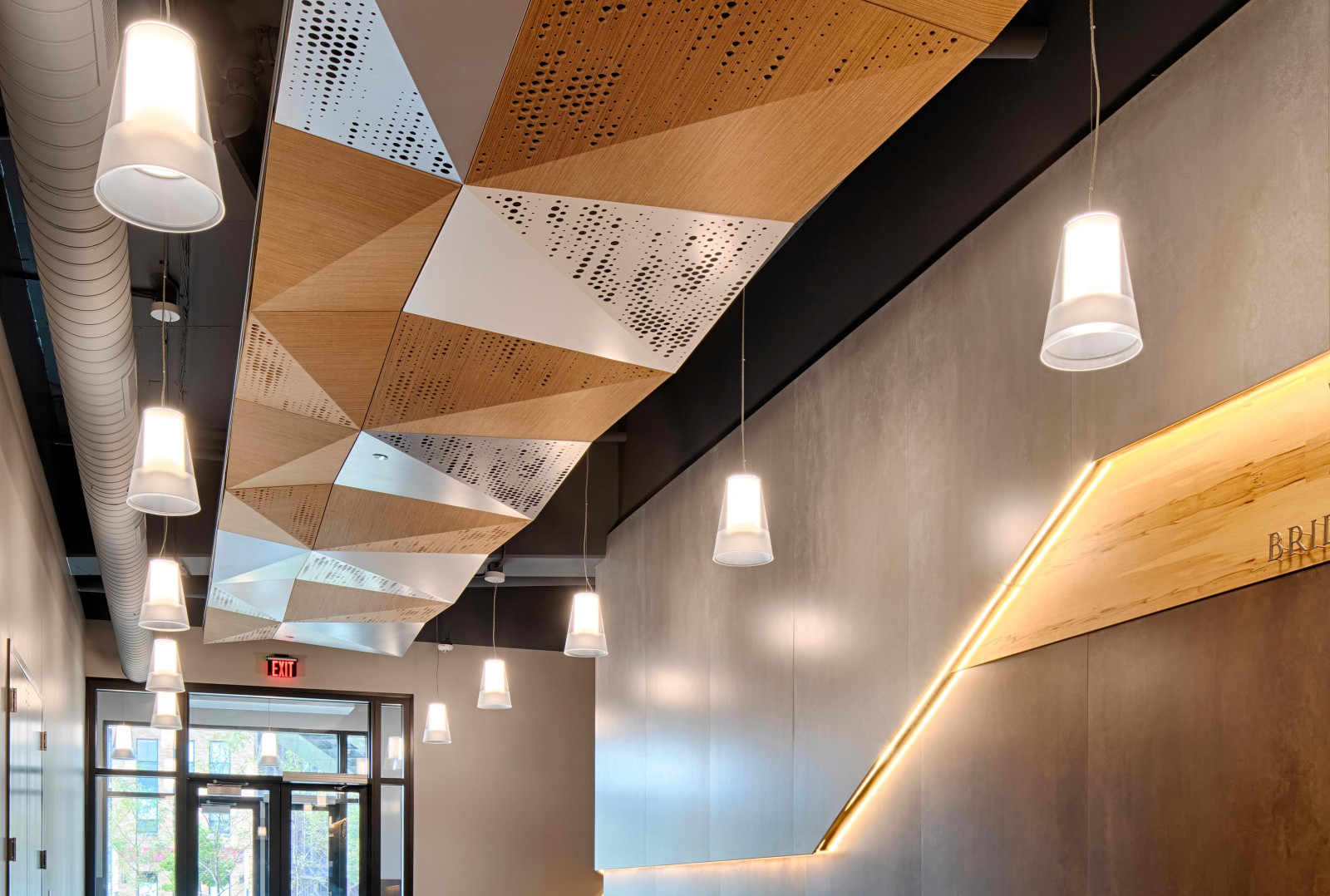Acoustic Wood Ceiling: Enhancing Sound And Aesthetic Appeal
Acoustic wood ceiling solutions have become increasingly popular in modern architecture and interior design. They offer a unique blend of functionality and aesthetics, making them an ideal choice for both residential and commercial spaces. With their ability to improve sound quality and create visually stunning environments, acoustic wood ceilings have revolutionized the way we think about indoor spaces.
As people spend more time indoors, the importance of creating comfortable and inviting spaces has grown significantly. Acoustic wood ceilings play a crucial role in achieving this goal by reducing noise pollution and enhancing the overall ambiance of a room. Whether you're designing a home theater, office space, or concert hall, acoustic wood ceilings provide an effective solution for managing sound while maintaining a beautiful design.
This article will delve into the world of acoustic wood ceilings, exploring their benefits, installation process, maintenance, and much more. By the end of this article, you'll have a comprehensive understanding of why acoustic wood ceilings are an excellent investment for your next project.
Read also:What Is March 2nd Zodiac Sign Discover Your Celestial Identity
Table of Contents
- Introduction to Acoustic Wood Ceiling
- Benefits of Acoustic Wood Ceiling
- Types of Acoustic Wood Ceiling
- Design Considerations
- Installation Process
- Maintenance Tips
- Cost Analysis
- Sustainability and Eco-Friendly Options
- Applications of Acoustic Wood Ceiling
- Future Trends in Acoustic Wood Ceiling
Introduction to Acoustic Wood Ceiling
Acoustic wood ceilings are specially designed to absorb, reflect, or diffuse sound waves, thereby improving the acoustic performance of a room. These ceilings are crafted from natural wood or engineered wood materials, ensuring both durability and aesthetic appeal. They are ideal for spaces where sound quality is critical, such as auditoriums, recording studios, and meeting rooms.
How Acoustic Wood Ceilings Work
Acoustic wood ceilings function by integrating sound-absorbing materials within their structure. These materials help to reduce echo and reverberation, creating a more balanced sound environment. Additionally, the natural texture and warmth of wood contribute to the overall visual appeal of the space.
Why Choose Acoustic Wood Ceilings?
Compared to traditional ceiling materials, acoustic wood ceilings offer several advantages. They combine the natural beauty of wood with advanced acoustic technology, providing a solution that is both functional and visually pleasing. Furthermore, they are available in a variety of styles and finishes, making them adaptable to different design aesthetics.
Benefits of Acoustic Wood Ceiling
Acoustic wood ceilings provide numerous benefits that make them an attractive option for architects, designers, and homeowners alike. Below are some of the key advantages:
Read also:Brock Lesnar Ncaa Record A Comprehensive Look At The Legends Achievements
- Improved Acoustic Performance: Reduces noise levels and enhances sound clarity.
- Aesthetic Appeal: Adds a touch of elegance and warmth to any space.
- Durability: Engineered to withstand wear and tear, ensuring long-term performance.
- Versatility: Available in various designs and finishes to suit different styles.
Health and Well-Being
One of the lesser-known benefits of acoustic wood ceilings is their positive impact on health and well-being. By reducing noise pollution, they create a more peaceful and comfortable environment, which can lead to improved concentration, productivity, and overall mental health.
Types of Acoustic Wood Ceiling
There are several types of acoustic wood ceilings available in the market, each with its own unique features and benefits. Understanding the differences between these options can help you make an informed decision for your project.
- Panel Ceilings: Modular panels that can be easily installed and customized.
- Suspended Ceilings: Suspended systems that offer flexibility and ease of installation.
- Perforated Ceilings: Ceilings with small perforations to enhance sound absorption.
Choosing the Right Type
When selecting an acoustic wood ceiling, consider factors such as the size of the space, the desired level of sound absorption, and the overall design aesthetic. Consulting with a professional can help ensure that you choose the best option for your specific needs.
Design Considerations
Designing an acoustic wood ceiling involves careful planning and attention to detail. Here are some important considerations to keep in mind:
- Room Dimensions: Ensure that the ceiling design complements the size and shape of the room.
- Color and Finish: Choose colors and finishes that align with the overall design theme.
- Lighting Integration: Incorporate lighting fixtures seamlessly into the ceiling design.
Trends in Acoustic Wood Ceiling Design
Current trends in acoustic wood ceiling design include the use of natural, sustainable materials and innovative shapes and patterns. Designers are increasingly experimenting with geometric patterns and custom designs to create unique and eye-catching ceilings.
Installation Process
Proper installation is crucial for ensuring the effectiveness and longevity of an acoustic wood ceiling. Below is a step-by-step guide to the installation process:
- Preparation: Clear the space and ensure that the ceiling surface is clean and level.
- Measurement: Measure the dimensions of the room to determine the number of panels needed.
- Installation: Follow the manufacturer's instructions for assembling and installing the panels.
DIY vs Professional Installation
While some acoustic wood ceilings can be installed as a DIY project, hiring a professional is often the best choice for ensuring a flawless result. Professionals have the expertise and tools necessary to handle complex installations and address any potential issues.
Maintenance Tips
To keep your acoustic wood ceiling looking its best, regular maintenance is essential. Here are some tips for maintaining your ceiling:
- Dust Regularly: Use a soft brush or cloth to remove dust and debris.
- Avoid Harsh Chemicals: Use mild cleaning products to avoid damaging the finish.
- Inspect for Damage: Regularly check for signs of wear and tear and address any issues promptly.
Extending the Lifespan
By following proper maintenance practices, you can significantly extend the lifespan of your acoustic wood ceiling. Additionally, consider periodic refinishing or restoration to maintain its appearance and performance.
Cost Analysis
The cost of acoustic wood ceilings can vary depending on factors such as material, design, and installation complexity. On average, prices range from $10 to $50 per square foot. While the initial investment may seem high, the long-term benefits and durability of acoustic wood ceilings make them a worthwhile investment.
Return on Investment
Acoustic wood ceilings can increase the value of a property and improve its appeal to potential buyers. Their ability to enhance sound quality and create a luxurious atmosphere makes them a desirable feature in both residential and commercial spaces.
Sustainability and Eco-Friendly Options
With growing concerns about environmental sustainability, many manufacturers are offering eco-friendly acoustic wood ceiling options. These products are made from responsibly sourced materials and are designed to minimize their environmental impact.
Benefits of Eco-Friendly Ceilings
Eco-friendly acoustic wood ceilings offer several benefits, including reduced carbon footprint, improved indoor air quality, and enhanced energy efficiency. By choosing sustainable options, you can contribute to a healthier planet while enjoying the benefits of high-quality acoustic performance.
Applications of Acoustic Wood Ceiling
Acoustic wood ceilings are versatile and can be used in a wide range of applications. Some common uses include:
- Residential Spaces: Home theaters, living rooms, and bedrooms.
- Commercial Spaces: Offices, conference rooms, and retail spaces.
- Public Spaces: Auditoriums, concert halls, and educational institutions.
Innovative Uses
Designers are constantly finding new and innovative ways to use acoustic wood ceilings. From custom installations in luxury homes to large-scale projects in public venues, the possibilities are endless.
Future Trends in Acoustic Wood Ceiling
The future of acoustic wood ceilings looks promising, with advancements in technology and materials driving innovation in the industry. Some emerging trends include:
- Smart Ceilings: Ceilings integrated with smart technology for enhanced functionality.
- Customizable Designs: Increased options for customization to meet individual preferences.
- Sustainable Solutions: Greater emphasis on eco-friendly and sustainable products.
Embracing the Future
By staying informed about the latest trends and developments, you can make the most of acoustic wood ceiling technology and create spaces that are both beautiful and functional.
Conclusion
Acoustic wood ceilings offer a unique combination of functionality and aesthetics, making them an excellent choice for a variety of applications. From improving sound quality to enhancing the visual appeal of a space, these ceilings provide numerous benefits that make them a worthwhile investment. By considering the factors discussed in this article, you can make an informed decision about incorporating acoustic wood ceilings into your next project.
We invite you to share your thoughts and experiences with acoustic wood ceilings in the comments below. Additionally, feel free to explore our other articles for more insights into interior design and architecture. Thank you for reading!
References:
- Architectural Acoustics Handbook - John C. Taylor
- Green Building Materials: A Guide to Product Selection and Specification - John Wiley & Sons
- Acoustic Design for Buildings - CRC Press

